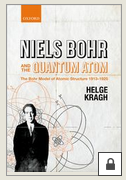With A. Sommerfeld's extension of the Bohr theory in 1915–1916, it was turned into a powerful tool of atomic research and adopted and further developed by German physicists in particular. The new and more general Bohr–Sommerfeld theory described the atom in terms of two quantum numbers, while Bohr had originally used only one quantum number. With this extension the theory provided an explanation of the Stark effect, the ordinary Zeeman effect, and the fine
structure of the hydrogen spectrum. Other developments based on X-ray spectroscopy were less successful, as were attempts to understand the structure of the helium atom. Yet, by 1920 nearly all physicists accepted the theory as the only viable framework for atomic and quantum research. But not all agreed:
|  |






 ||Message]
||Message]
